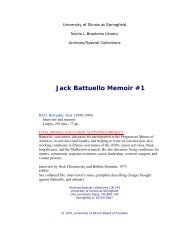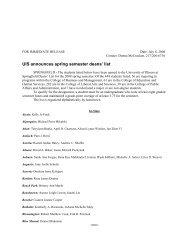Leland J. Kennedy Memoir - University of Illinois Springfield
Leland J. Kennedy Memoir - University of Illinois Springfield
Leland J. Kennedy Memoir - University of Illinois Springfield
Create successful ePaper yourself
Turn your PDF publications into a flip-book with our unique Google optimized e-Paper software.
A: Wrll they had sample boys. A sample boy was - it was on the seniority system, and<br />
he washed - a lot <strong>of</strong> the samples came in in bottles. And they'd ship a lot <strong>of</strong> oil products<br />
in bottles, just quart bottles for samples. It was a sample testing laboratory that tested various<br />
competitors' products and they'd all - it seemed like 75 percent <strong>of</strong> them came in bottles<br />
and we just had a bottle washing machine that would feed in hot water or lukewarm water<br />
and rinse them out, and then we'd put them on a dryer. And you never lacked for<br />
work. (chuckles)<br />
Q: Well.<br />
A: They saw to that, you never lacked for work.<br />
Q: How soon did you move up to being a sample carrier'!<br />
A: Well pretty quick. I was just going to say about - well I only worked - the bottle<br />
washer was strictly a day job. And I got prornotcd to sample carrier - I started in July,<br />
and hell, 1 was carrying samples by Labor Day I'm sure. I'm sure I started the middle or<br />
latter part <strong>of</strong> August. We worked three shifts, eight to four, four to twelve, and twelve<br />
to eight, and my first duties as a sampler was going to work on the graveyard. And I know<br />
there was a big tank across from the laboratory. The first tank I sampled was that tank.<br />
Q: Now how did you go about that? Did you just open the tank and dish it out?<br />
A: Well you had a belt to carry your quart bottle in, a sample-carrying belt. And just clumb<br />
up the tank. You had to be pretty agile, be careful, most tanks now have a guard, top and<br />
bottom you know. If you notice when you go out to a refinery, you'll see - <strong>of</strong> course most<br />
<strong>of</strong> them have steps. Now some <strong>of</strong> them did have, some had steps, but most <strong>of</strong> the tanks<br />
we sampled in my career as a sample carrier the only place they had a guard was when<br />
you got up on top and you opened up the top <strong>of</strong> the tank and you'd lean back, the guard<br />
rail was what they called it, and you'd take your sample. You kept a quart bottle container<br />
as they called it, with a chain, you kept it on top <strong>of</strong> the tank, and then you'd put your bottle<br />
in that carrier and lower it into the tank.<br />
Q: I see.<br />
A: And if a tank was full, sometimes you'd have to get top, middle and bottom. You'd have<br />
to get three samples. And you wouldn't have to make three trips up the ladder, but you'd<br />
lower the samples as you got them. You'd have a cork and you'd put it in. And lower them<br />
down. It was manual labor I guess, classified as manual labor. You didn't get too many<br />
top and bottoms, but sometimes some chemist would get - and more power to them - would<br />
get the idea, I guess they wanted to see if they were stratified, I suppose, you know. Maybe<br />
they'd have to agitate it more or the petroleum product maybe it was a blend going to go<br />
to some special customer, and they wanted it to he as near mixed as it could be, and<br />
that's . . .<br />
Q: How did they go about mixing it? Did they have a - something . . .<br />
A: Well they had an agitation. Some tanks you could put air in. But most <strong>of</strong> the mixings<br />
were done in the old Shell refinery where I worked in what they called backs agitators. Now<br />
we in the laboratory didn't do that.<br />
Now, it wasn't long - I think by Christmas I was up to tester in that laboratory. And we<br />
got double-time on Christmas, I remember that. The Fourth <strong>of</strong> July and Christmas. We<br />
got double-time on two days.<br />
Q: Well!
















